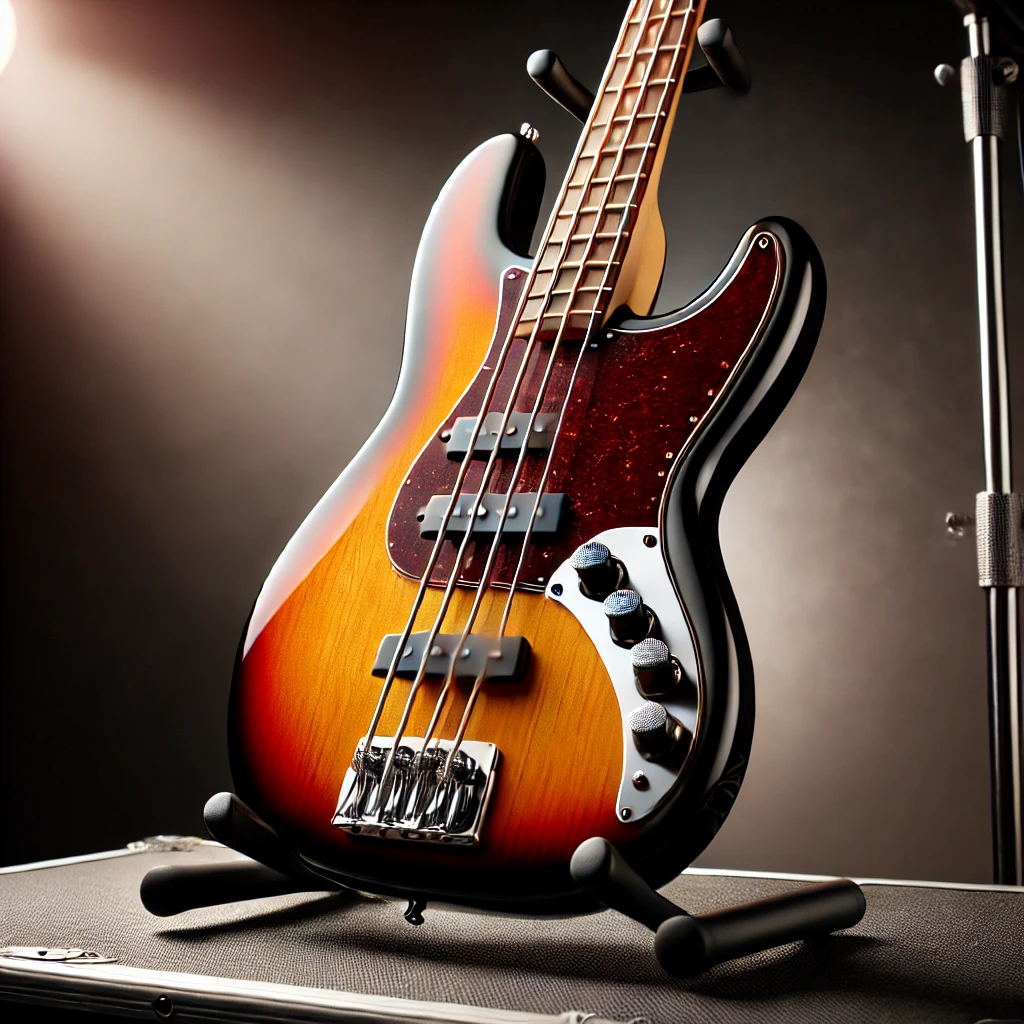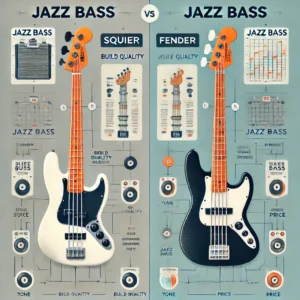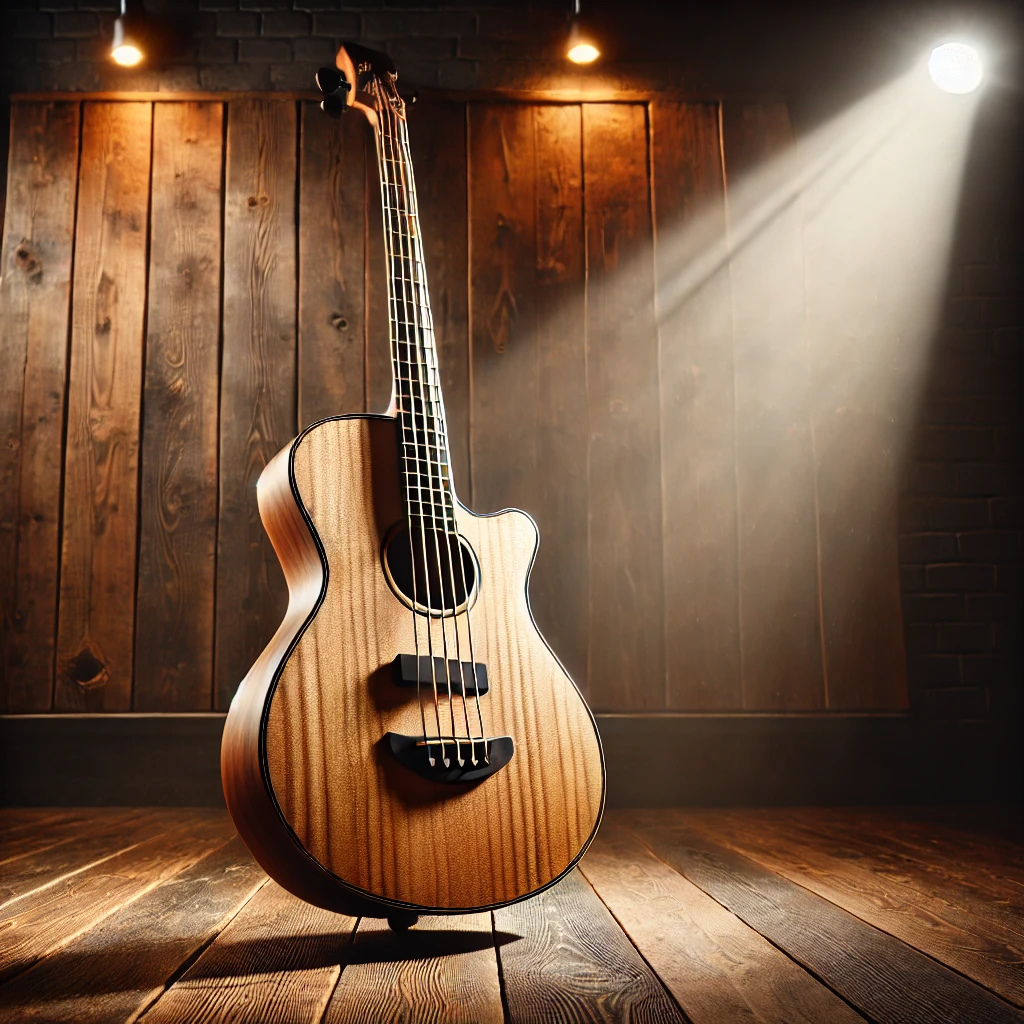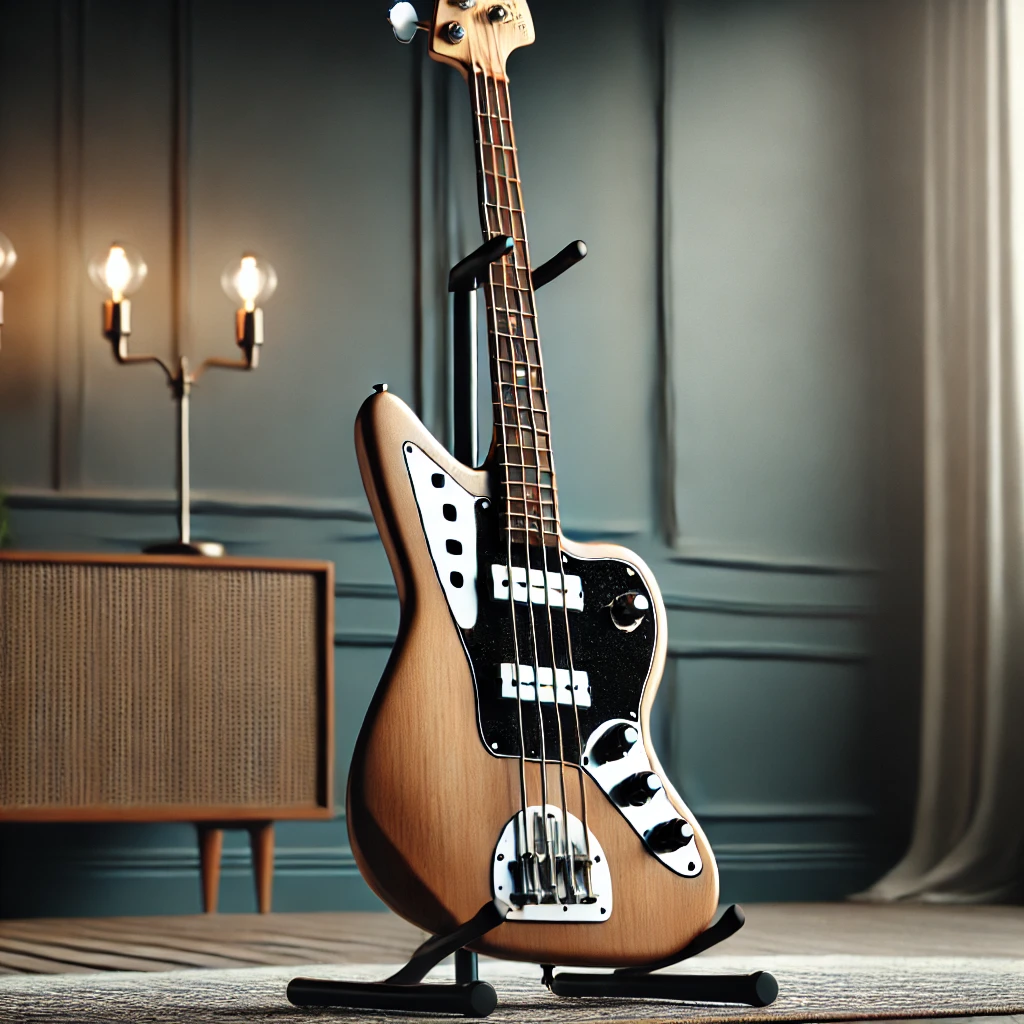The Allure of the Squier Jazz Bass 🎸
Have you ever picked up a bass guitar and felt an instant connection? That feeling when the instrument seems to become an extension of yourself? Well, I certainly have, and my journey with the Squier Jazz Bass has been nothing short of remarkable. As a passionate bassist and gear enthusiast, I’ve spent countless hours exploring various instruments, but there’s something special about the Squier Jazz Bass that keeps drawing musicians back time and again.
The Squier Jazz Bass represents more than just an affordable alternative to the iconic Fender Jazz Bass – it’s a legitimate musical tool that has earned its place on stages and in studios worldwide. Whether you’re a beginner looking for your first quality instrument or an experienced player seeking a reliable backup, the Squier Jazz Bass delivers exceptional value without breaking the bank.
In this comprehensive guide, we’ll dive deep into everything you need to know about the Squier Jazz Bass – from its rich history and various models to sound characteristics, modifications, and practical tips for getting the most out of this fantastic instrument. So, grab your favorite pick (or use your fingers – no judgment here!), and let’s explore the wonderful world of Squier Jazz Bass guitars!
The Evolution of the Squier Jazz Bass: A Brief History ⏳
Before we delve into the specifics, understanding the origins of the Squier Jazz Bass provides valuable context for appreciating these instruments.
The story begins in the late 1970s when Fender found itself competing with high-quality Japanese copies of its iconic designs. Rather than simply fighting against these manufacturers, Fender made a strategic decision – they acquired the Squier brand (originally a string manufacturer) and transformed it into their budget-friendly line of instruments.
The Squier Jazz Bass first appeared in the early 1980s as part of the “JV” (Japanese Vintage) series, which quickly gained recognition for exceptional quality. Over the decades, Squier has evolved substantially:
- ✅ 1982-1984: The legendary JV series Squier basses were manufactured in Japan with remarkable quality, sometimes rivaling their American counterparts
- ✅ Late 1980s-1990s: Production expanded to other Asian countries with varying quality control
- ✅ 2000s: Significant improvements in manufacturing processes and quality standards
- ✅ Today: Modern Squier Jazz Basses offer unprecedented value with consistent quality across various product lines
What’s fascinating is how the Squier Jazz Bass has transitioned from being considered merely a “beginner’s instrument” to earning respect from professional musicians who recognize its exceptional value proposition. Many bassists now proudly use these instruments for recording and live performances without hesitation.
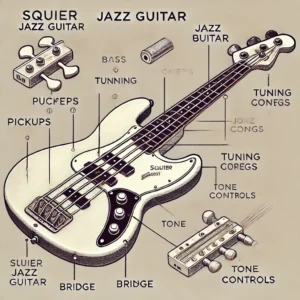
Understanding the Squier Jazz Bass Lineup: Finding Your Perfect Match 🔍
One of the most exciting aspects of exploring the Squier Jazz Bass world is discovering the variety of models available. Each series offers different features, tonewoods, and price points to match your specific needs and preferences. Let’s break down the current lineup:
Affinity Series: The Gateway to Jazz Bass ⚡
The Affinity Series represents Squier’s entry-level offering, but don’t let that classification fool you. These instruments provide remarkable quality for their price point. With a slimmer body than higher-end models and simplified electronics, Affinity Jazz Basses offer:
- Comfortable C-shaped maple necks
- Good quality open-gear tuners
- Standard single-coil Jazz Bass pickups
- Versatile tone controls
For beginners or players on a tight budget, the Squier Affinity Series Jazz Bass offers exceptional value. While it may lack some refinements of higher-end models, it delivers the essential Jazz Bass experience and can be easily upgraded over time.
Classic Vibe Series: Vintage Inspiration, Modern Performance 🔥
The Classic Vibe series has garnered a cult following among bassists for its remarkable quality-to-price ratio. These instruments draw inspiration from specific decades (50s, 60s, 70s) with period-correct details and superior components:
- Alnico pickups with rich, vintage-inspired tones
- Premium tonewoods including pine and poplar bodies
- Nickel-plated hardware
- Detailed finish options reflecting specific eras
The Squier Classic Vibe ’60s Jazz Bass stands out as one of the most popular models, offering impressive tonal versatility and build quality that rivals instruments costing significantly more. Many professional bassists keep these as reliable backups or even primary instruments.
Contemporary Series: Modern Features for Today’s Players 🚀
For bassists seeking more modern appointments and playing experiences, the Contemporary series delivers with forward-thinking features:
- Active electronics with 9V battery power
- High-output ceramic pickups
- Sleek finishes with matching headstocks
- Modern neck profiles optimized for faster playing
The Squier Contemporary Active Jazz Bass HH deserves special attention with its dual humbucking pickups and active 2-band EQ, offering massive tonal flexibility for genres ranging from funk to metal.
Paranormal Series: Unconventional and Creative Designs 🌟
The Paranormal series represents Squier’s experimental side, offering unique “what if” instrument designs that deviate from traditional templates. While specific Jazz Bass offerings vary by year, these instruments typically feature:
- Hybrid designs combining elements from different bass models
- Unique pickup configurations
- Special finishes and aesthetic touches
- Unexpected ergonomic innovations
Comparing Top Squier Jazz Bass Models: Finding Your Perfect Match
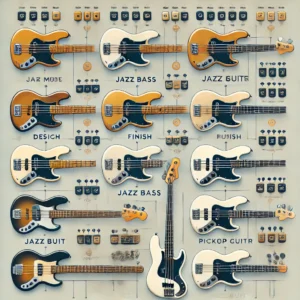
To help you make an informed decision, let’s compare some of the most popular Squier Jazz Bass models currently available:
| Model | Body Wood | Pickups | Neck Profile | Best For | Approximate Price |
|---|---|---|---|---|---|
| Squier Affinity Jazz Bass V | Poplar | Standard Single-Coil | “C” Shape | Beginners, 5-string enthusiasts | $279-$329 |
| Squier Classic Vibe ’60s Jazz Bass | Poplar | Alnico Single-Coil | “C” Shape | Vintage tone seekers, intermediate players | $399-$449 |
| Squier Contemporary Active Jazz Bass HH | Poplar | Ceramic Humbuckers | “C” Shape | Modern players, genre-hoppers | $429-$479 |
| Squier Classic Vibe ’70s Jazz Bass | Soft Maple | Alnico Single-Coil | “C” Shape | Retro aesthetics, warm tone fans | $399-$449 |
Ready to elevate your bass playing journey? Check out these exceptional Squier Jazz Bass models on Amazon today and find the perfect instrument to match your playing style and budget! Your musical future is just one click away. 🎵
The Signature Squier Jazz Bass Sound: What Makes It Special 🎵
What exactly gives the Jazz Bass its distinctive tonal character? The Squier Jazz Bass captures the essence of this iconic sound through several key design elements:
Pickup Configuration and Electronics
The standard Jazz Bass configuration features two single-coil pickups positioned at different points along the strings:
- Bridge pickup: Produces brighter, more aggressive tones with enhanced definition
- Neck pickup: Delivers warmer, fuller sounds with more fundamental frequencies
- Individual volume controls: Allow precise blending of both pickups
- Master tone control: Provides additional tonal shaping
This versatile setup allows players to achieve an impressive range of sounds simply by adjusting the balance between pickups. Blending both pickups at equal volumes creates the classic “scooped” Jazz Bass sound with reduced midrange – perfect for slap techniques and punchy fingerstyle playing.
Neck Profile and Playability
Another defining characteristic of the Squier Jazz Bass is its comfortable neck profile:
- Narrower nut width than Precision Bass models (typically 1.5″ vs 1.625″)
- Sleek “C” shaped profile that facilitates faster playing
- Smooth transition between positions for effortless navigation
- Comfortable string spacing that works well for variety of techniques
Many bassists, especially those with smaller hands or players transitioning from guitar, appreciate the Jazz Bass neck’s comfortable dimensions and responsive feel.
Maximizing Your Squier Jazz Bass: Tips and Tricks 💡
Owning a Squier Jazz Bass opens up a world of possibilities for sonic exploration and personalization. Here are some practical tips to help you get the most from your instrument:
Setting Up Your Squier Jazz Bass Properly
A proper setup makes a tremendous difference in how any bass plays and sounds:
- String Height (Action): Start with approximately 2mm clearance at the 12th fret (low E string) and 1.5mm (G string), then adjust to your preference
- Neck Relief: Aim for slight forward bow (about 0.3mm at 7th fret when holding down first and last frets)
- Intonation: Ensure accurate tuning across the entire fretboard by adjusting saddle positions
- Pickup Height: Position pickups approximately 3mm from strings when fretted at last fret for balanced output
Consider investing in the StewMac Bass Setup Kit which contains precision tools for measuring and adjusting these crucial parameters.
String Choices for Enhanced Sound
Your choice of strings dramatically impacts your Squier Jazz Bass’s tone:
- Roundwound strings: Bright, articulate tone with pronounced harmonics – great for slap, pick playing, and cutting through a mix
- Flatwound strings: Smooth, warm tone with minimal finger noise – perfect for vintage sounds and recording
- Halfwound/groundwound strings: A middle ground between the above options
The D’Addario ECB81 Chromes Bass Strings offer exceptional flatwound tone and comfort, while the Ernie Ball Regular Slinky Nickel Wound Bass Strings provide the classic bright roundwound sound many Jazz Bass players prefer.
Essential Squier Jazz Bass Modifications
While Squier Jazz Basses offer excellent value stock, strategic modifications can elevate them further:
- Upgraded Pickups: Replacement pickups like the Fender Pure Vintage ’64 Jazz Bass Pickup Set can transform your instrument’s voice
- Better Bridge: A high-mass bridge like the Fender HiMass 4-String Bass Bridge improves sustain and stability
- New Tuners: Premium tuners such as Hipshot HB2 Bass Tuning Machines enhance tuning stability and reduce weight
- Electronics Upgrades: Consider the Fender Jazz Bass Wiring Kit for improved pots, capacitors, and output jack
Amplification: Complementing Your Jazz Bass Tone
The right amplification helps showcase your Squier Jazz Bass’s natural voice:
- Solid-state amps: Clean, punchy sound with excellent definition
- Tube amps: Warm compression and natural overdrive when pushed
- Modern class-D designs: Lightweight options with powerful, clear projection
The Fender Rumble 40 V3 Bass Combo Amplifier pairs particularly well with Jazz Basses, offering a range of tones from vintage warmth to modern clarity in a portable package.
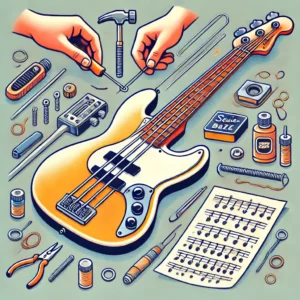
Common Questions About Squier Jazz Bass Instruments 🤔
Let’s address some frequently asked questions about Squier Jazz Basses:
Is a Squier Jazz Bass Good for Beginners?
Absolutely! The Squier Jazz Bass represents an ideal starting point for several reasons:
- Comfortable neck dimensions that accommodate developing technique
- Versatile tone suitable for exploring different musical styles
- Reasonable price point that doesn’t require excessive investment
- Availability of different models to match specific preferences
- Established design with abundant learning resources available
While the Affinity series offers the most accessible entry point, even beginners might consider stretching their budget for a Classic Vibe model if possible, as the improved quality can enhance the learning experience and provide longer-term satisfaction.
How Does a Squier Jazz Bass Compare to a Genuine Fender?
This common question deserves a nuanced answer:
- Construction: Fender models typically feature more premium woods, though the gap has narrowed with higher-end Squier lines
- Hardware: Fender basses generally include higher-grade tuners, bridges, and pickups
- Craftsmanship: Fender instruments receive more detailed attention during manufacturing and setup
- Consistency: Fender maintains tighter quality control tolerances between instruments
- Tonal characteristics: Core sound remains similar, with Fenders often offering more tonal complexity
However, the value proposition of Squier cannot be overstated – modern Classic Vibe and Contemporary models deliver approximately 80-90% of the Fender experience at roughly 30-40% of the cost. Many professional bassists now incorporate Squier instruments into their arsenal without hesitation.
Which Famous Bassists Use Squier Jazz Basses?
While many professional bassists have signature Fender models, several notable players have embraced Squier Jazz Basses either early in their careers or as reliable alternatives:
- Gary “Mani” Mounfield (The Stone Roses, Primal Scream) has been spotted using Squier models
- Several touring bassists utilize modified Classic Vibe models as backup instruments
- Numerous session players appreciate Squier Jazz Basses for recording situations where tone matters more than brand prestige
The increasing quality of Squier instruments has diminished the stigma once associated with these more affordable options.
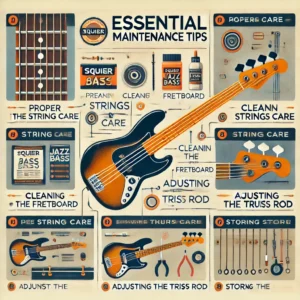
Mastering Your Squier Jazz Bass: Technique and Style Development 🎯
Owning a Squier Jazz Bass opens the door to developing various playing techniques that showcase the instrument’s versatility:
Fingerstyle Fundamentals
The Jazz Bass design particularly shines when played with fingers:
- Alternating finger technique: Develop consistent alternation between index and middle fingers
- Plucking position: Experiment with playing near the bridge for brightness or closer to the neck for warmth
- Muting: Master palm muting with your right hand while controlling unused strings with left-hand fingers
Slap and Pop Techniques
The narrow string spacing and bright tone make Jazz Basses excellent for slap techniques:
- Thumb strike: Develop a consistent motion striking through the string rather than just hitting it
- Popping: Use index or middle finger to pull strings away and release for the characteristic pop sound
- Thumb positioning: Find the sweet spot between the end of the fingerboard and front pickup
Pick Playing Approaches
Don’t overlook the potential of using a pick with your Jazz Bass:
- Pick selection: Experiment with different thicknesses (0.73mm-1.14mm typically work well)
- Angling: Slight pick angle produces smoother tone than perpendicular striking
- Bridge pickup emphasis: Using more bridge pickup typically complements picked playing
The Dunlop Tortex Standard Guitar Picks Variety Pack offers an excellent assortment for discovering your preferred thickness and material.
Care and Maintenance: Preserving Your Squier Jazz Bass 🧰
Proper maintenance ensures your Squier Jazz Bass will provide years of reliable service:
Regular Cleaning Routine
Establish these habits for keeping your instrument in top condition:
- Wipe down the entire bass with a soft cloth after each playing session
- Clean strings with a microfiber cloth to remove oils and extend life
- Periodically apply appropriate polish to finished surfaces
- Use specialized fretboard conditioner for unfinished fingerboards
The Music Nomad Premium Guitar Care System includes everything needed for proper maintenance in one convenient package.
Storage Considerations
How you store your Squier Jazz Bass affects its longevity:
- Store in a case or gig bag when not in use to prevent dust accumulation and accidental damage
- Maintain moderate humidity (45-55%) to prevent wood shrinkage or expansion
- Avoid extreme temperature fluctuations that can stress components
- Consider wall hangers for convenient access without compromising safety
When to Seek Professional Service
While many maintenance tasks can be performed at home, recognize when professional help is beneficial:
- Fret leveling or replacement when wear becomes noticeable
- Electronics repair if controls become noisy or inconsistent
- Neck adjustments if basic truss rod tweaks don’t resolve issues
- Bridge or nut replacement for improved intonation and playability
The Cultural Impact of the Squier Jazz Bass 🌍
Beyond its technical specifications and tonal characteristics, the Squier Jazz Bass has made a significant cultural impact:
Democratizing Quality Instruments
Perhaps the most important contribution of the Squier Jazz Bass has been making quality instruments accessible to players regardless of economic circumstances:
- Enabled countless musicians to begin their journey on properly designed instruments
- Reduced barriers to entry for aspiring bassists
- Provided viable alternatives to questionable “no-name” budget instruments
- Expanded the total community of bass players worldwide
Shifting Perceptions of “Budget” Instruments
The Squier brand, particularly through the Jazz Bass, has helped transform how musicians view more affordable instruments:
- Challenged the assumption that professional-quality sound requires premium prices
- Encouraged evaluation based on actual performance rather than headstock logos
- Normalized the use of “budget” instruments in professional contexts
- Inspired other manufacturers to improve quality at lower price points
Conclusion: Why the Squier Jazz Bass Deserves Your Attention 🏆
After exploring the world of Squier Jazz Bass instruments, one thing becomes abundantly clear – these basses represent one of the best values in the musical instrument industry today. From the accessible Affinity models to the premium-feeling Classic Vibe series, Squier offers something for virtually every bassist and budget.
What makes the Squier Jazz Bass truly special isn’t just its affordability or iconic design – it’s the possibility it represents. This instrument opens doors to creative expression without financial barriers. It embodies the democratic idea that quality musical tools should be available to all passionate players, not just those with substantial disposable income.
Whether you’re just starting your bass journey or adding another tool to your musical arsenal, the Squier Jazz Bass deserves serious consideration. With their combination of playability, versatility, and value, these instruments have earned their place in music history not merely as “budget alternatives” but as legitimate musical tools in their own right.
Ready to experience the legendary Squier Jazz Bass for yourself? Browse the full range of models on Amazon today and take the next step in your musical journey. Your perfect bass is waiting – all you need to do is make that choice! 🎸
More FQAs:
❓ What are the main differences between Squier Jazz Bass models?
✅ Squier offers various Jazz Bass models, including the Affinity Series, Classic Vibe Series, and Contemporary Series, each differing in materials, pickups, and finishes to cater to different preferences...
❓ Is the Squier Jazz Bass suitable for beginners?
✅ Yes, the Squier Jazz Bass is ideal for beginners due to its affordability, playability, and quality construction, providing a solid foundation for learning bass guitar...
❓ How does the Squier Jazz Bass compare to the Fender Jazz Bass?
✅ While Fender Jazz Basses are premium instruments, Squier Jazz Basses offer similar designs at a more affordable price, making them accessible without compromising essential features...
❓ Can the Squier Jazz Bass be used for professional performances?
✅ Absolutely, many musicians use Squier Jazz Basses in professional settings, appreciating their reliability and tonal versatility...
❓ What maintenance does a Squier Jazz Bass require?
✅ Regular maintenance includes cleaning the fretboard, checking the neck's straightness, adjusting the action, and ensuring the electronics function properly...
Recommended for You:
- Discover the Perfect Bass Guitar with Case: Ultimate Guide to Protect Your Investment 2025
- The Ultimate Guide to 4 String Electric Bass: Top Picks & Expert Tips for 2025
- Unlock the Ultimate Guide to Bass Akustik 2025: Discover Powerful Sound Without Amplification
Disclaimer: This article contains affiliate links. If you purchase products through these links, we may earn a small commission at no additional cost to you.
